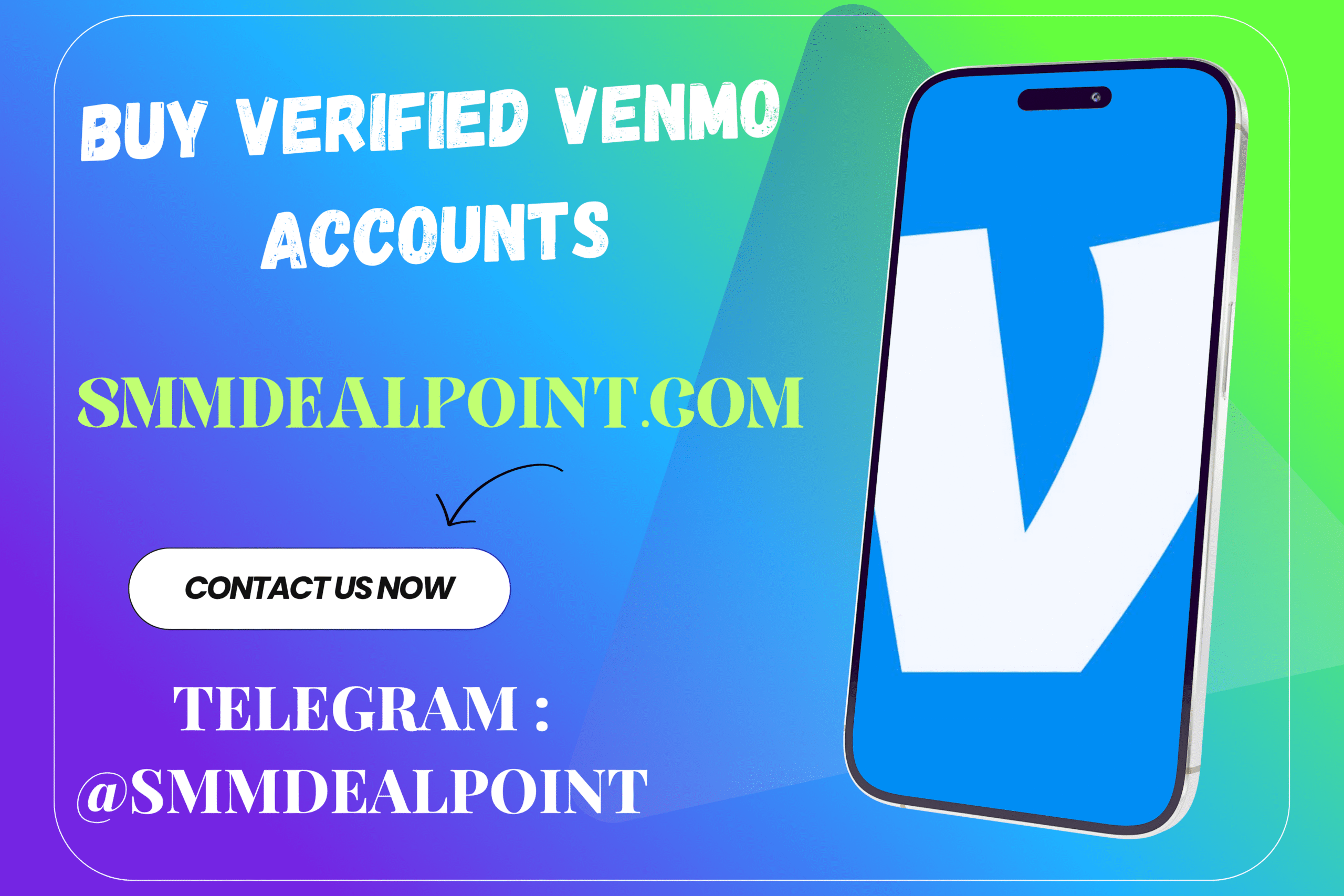Buy Verified Venmo Accounts
Buy Verified Venmo Accounts is one of the most popular mobile payment apps in the U.S., used by millions to send money to friends, pay for goods, or accept small business payments. To unlock the app’s full functionality — including higher weekly send limits, access to your Venmo balance for payments, and certain business features — Venmo requires identity verification. This guide explains what Venmo verification is, why it matters for both private users and businesses, how to verify step-by-step, and how to keep your account secure and compliant.
(Important sources for core facts used in this article: Venmo Help Center identity verification and limits pages.)
What is Venmo identity verification?
Identity verification on Buy Verified Venmo Accounts is the process of confirming a user’s legal identity so Venmo and its payment processors can comply with regulatory requirements (like anti-money-laundering rules), support certain product features, and set appropriate transaction limits. Typical verification asks for full legal name, date of birth, address, and Social Security Number (or last 4 digits of SSN) and may request government-issued ID or other documents if automatic checks fail.
Why does Venmo ask for this? Verification allows Venmo to:
-
Let you use funds in your Venmo balance for payments.
-
Increase rolling weekly limits so you can send and receive larger amounts.
-
Enable business profile verification for merchants and creators.
Why verifying your Venmo account matters (personal & business)
Verification matters for several practical reasons:
-
Higher transaction limits. Unverified users face a rolling weekly limit (commonly around $299.99 for sending); verified users can access significantly higher limits — Buy Verified Venmo Accounts states verified users may be able to send much larger weekly amounts (up to the platform’s verified limit, which Venmo documents).
-
Use your Venmo balance for payments. Venmo sometimes restricts balance use until your identity is verified. Completing verification gives you full access to any funds received.
-
Business features & trust. Verified business profiles provide buyers confidence and are often required to accept certain payment types or higher volumes. Venmo’s business profile verification flow is separate and may require business documents.
-
Easier dispute handling and regulatory compliance. Verified identities speed up support and reduce the risk of account freezes during compliance checks.
In short: verification reduces friction, raises limits, and improves account functionality — provided you follow Venmo’s official processes.
 Venmo verification: step-by-step (personal accounts)
Venmo verification: step-by-step (personal accounts)
Here’s how to verify a personal Venmo account using the official in-app flow. If Venmo can’t automatically confirm your info, they will request supporting documents.
-
Open the Venmo app and tap Me (your profile).
-
Tap the Settings (gear) icon.
-
Tap Identity Verification (or tap any identity/verification prompts you see).
-
Enter requested personal details: legal full name, date of birth, home address, and the last 4 digits of your Social Security Number (SSN). Venmo may require the full SSN in some cases.
-
If Venmo cannot verify automatically, follow the in-app prompts to upload government ID (passport, driver’s license, state ID) and proof of address (if requested). Keep photos clear and show full document edges.
-
Wait for Venmo’s review. Automated checks are often quick; manual reviews can take longer. You’ll receive status updates in-app or by email.
Pro tips: match names and addresses exactly across your bank, ID, and Venmo profile to avoid rejections; respond promptly if Venmo requests additional documents.
Verifying a Venmo business profile
If you accept payments for goods or services, you can set up a Venmo business profile (available within the app) which is distinct from personal accounts and has its own verification needs.
How to get started:
-
From your profile, tap Create a business profile and follow the onboarding flow.
-
Venmo will try to verify your business from national databases. If automatic verification fails, you’ll be asked to submit business documents (certificate of registration, tax ID, proof of address, etc.).
-
Once verified, your business profile will display on Venmo and you’ll be able to accept merchant payments—keep in mind payment rails and payout timing may vary by region and processor.
Businesses must be transparent about their goods/services and comply with Venmo’s merchant terms and any applicable local regulations.
Venmo limits: what changes after verification
Buy Verified Venmo Accounts uses rolling limits: amounts count toward your weekly totals for seven days after each transaction. Key points:
-
Unverified users often see a modest weekly sending limit (commonly ~$299.99). This cap includes person-to-person payments and merchant purchases.
-
Verified users can access significantly higher weekly sending limits (Venmo documents verified limits and may allow up to tens of thousands depending on account history and compliance checks). Venmo’s official limits page describes the verified thresholds.
-
Bank and transfer limits (like instant transfers to bank accounts) may have separate caps and fees depending on the method (instant vs. standard ACH), and Venmo may require additional verification for some transfer types. See Venmo’s bank-linking guidance for details.
Always check your in-app Limits page for the exact numbers on your account — Venmo personalizes limits based on verification and account history.
Linking banks & cards safely
Linking a bank account or card securely is essential to use Venmo fully:
-
Instant bank verification uses services like Plaid; you enter your online banking credentials in Venmo’s secure flow and the bank is verified immediately.
-
Micro-deposit verification posts small amounts to your bank which you then confirm in the app if instant verification isn’t available.
-
Cards: Adding a debit or credit card requires the card number, expiry, and CVV. Note: credit card payments typically incur a fee (Venmo shows any fees at checkout).
-
Security: Never share passwords or verification codes outside the official Venmo app, and check that you’re on the official Venmo domain or app before entering details.
Security best practices (must-do)
Verification reduces risk but doesn’t replace good security hygiene:
-
Enable two-factor authentication (2FA) for your Venmo account (use an authenticator app or the app’s PIN/biometrics).
-
Use a strong, unique password stored in a password manager.
-
Monitor active sessions and revoke devices you don’t recognize.
-
Turn off social sharing or set privacy to Private for transactions you don’t want publicly visible. Venmo’s default social feed shows transactions with comments unless you change privacy settings.
-
Keep personal and business activity distinct — use a business profile for sales to simplify bookkeeping and dispute handling.
-
Be wary of phishing — Venmo will not ask for your password or 2FA codes via email or text. Log in only through the official app or venmo.com.
If your account is compromised, change passwords immediately, revoke sessions, and contact Venmo support.
Recovering legacy (old) Venmo accounts
If you have an old Venmo account you no longer access or that requires re-verification:
-
Start with account recovery flows at login (use “Forgot password” or “Need help signing in”).
-
Have proof of ownership ready: original registration email, past transaction receipts, linked bank account screenshots, or other evidence of past use. These speed up recovery with Venmo support.
-
Respond to in-app verification requests quickly — if policy changes require re-verification, providing up-to-date ID and address docs will hasten approval.
-
If you changed your phone number or email, update contact methods in the app or provide associated supporting docs during recovery.
Legacy accounts with transaction history generally have stronger cases for ownership verification; be patient when working with support.
Taxes, recordkeeping, and merchant tips
If you accept payments for goods or services on Venmo, you have obligations:
-
Tax reporting: Income received through Venmo for business purposes is taxable. Keep clear records of payments, invoices, fees, and business expenses. Venmo (and PayPal) may issue tax forms (e.g., 1099-K) based on thresholds—monitor Venmo notifications and consult a tax professional.
-
Separate accounts: Use a dedicated business profile or a separate business financial account to keep personal and business transactions clean.
-
Receipts & refunds: Provide clear receipts and refund policies in case of disputes and for recordkeeping.
 Common verification problems & troubleshooting
Common verification problems & troubleshooting
Rejected identity checks? Ensure your ID photos are high resolution, uncropped, and show full document edges. Names and addresses must match your bank and profile details.
Long verification delays? Automated checks are usually fast; manual reviews can take longer. If it’s been several days, contact Venmo support through the app rather than resubmitting multiple times (which may slow processing).
Country limits: Buy Verified Venmo Accounts is U.S. focused — non-U.S. residents have fewer options. If you moved countries, expect re-verification for new residency rules.
FAQ (short, SEO-friendly)
How long does Venmo verification take?
Many verifications are instant via automated checks; manual reviews typically take a few hours to a few business days.
What changes after I verify on Venmo?
Verified accounts usually unlock the ability to use your Venmo balance for payments and access much higher weekly send limits.
Do I need to verify to accept merchant payments?
For a business profile and higher volumes, yes — Venmo has a separate business verification process and may request business documents.
Is Venmo safe for business transactions?
Buy Verified Venmo Accounts is convenient for small merchant payments, but businesses should use verified business profiles, keep records, and be mindful of buyer protection limits and dispute rules.
Conclusion
Verifying your Venmo account the right way is the safest and most sustainable path to unlocking higher limits, using your Venmo balance for payments, and operating as a small merchant on the platform. Never try to buy a “verified” account — using someone else’s account or falsified documents risks permanent suspension, frozen funds, and legal exposure. Instead, follow the official in-app verification flow, keep your documents accurate and current, enable strong security protections, and maintain clear records for taxes and dispute resolution




Reviews
There are no reviews yet.